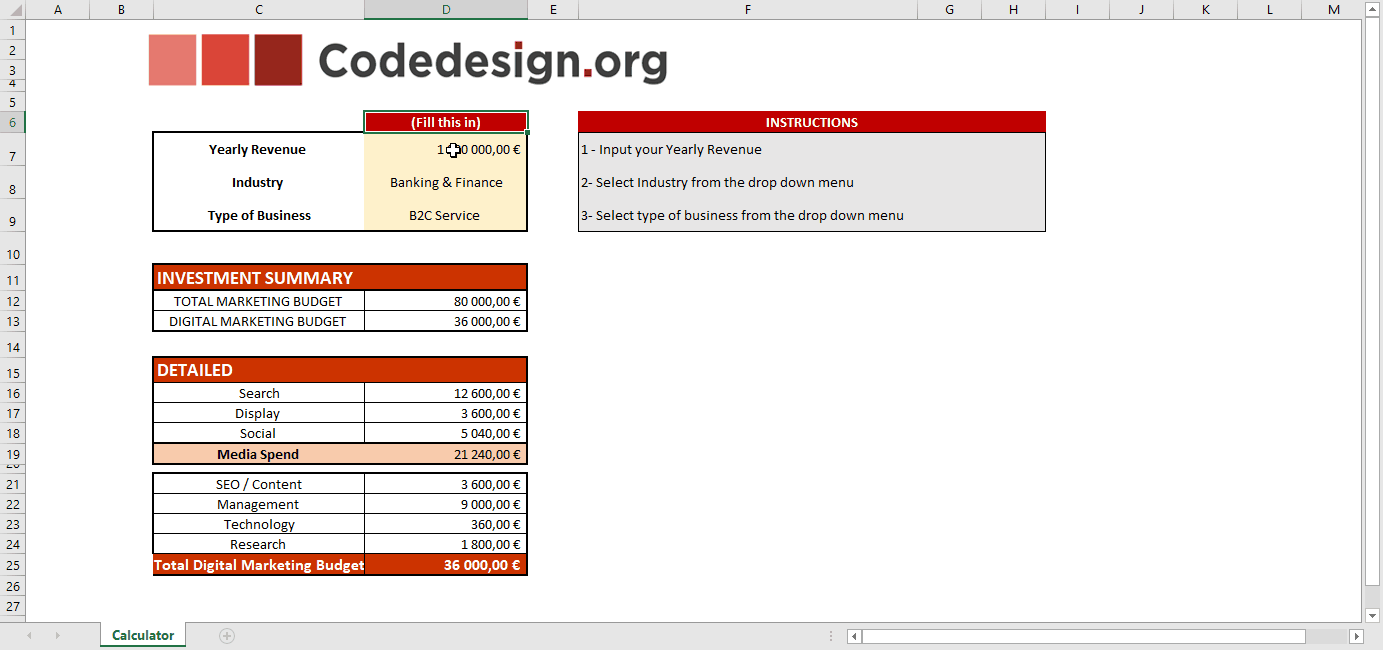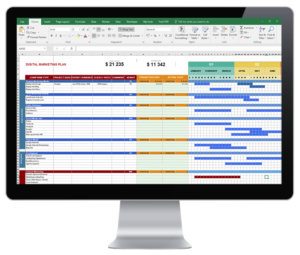5 min to read
IMPORTANT INFORMATIONLike all forecasting tools and models, proper research and experience are critical to create an accurate Digital Marketing Plan. |
Running a successful business is all about numbers. But how do you know ahead of time which numbers will have the right effect on your P&L?
Calculating your digital marketing budget can seem like a daunting task, especially for companies without a lot of historical figures to rely on.
If you're working out your digital marketing budget for the very first time, it can be difficult to predict whether it’s adequate. You could be allocating too much of your digital marketing budget towards content marketing, and not seeing the results you had expected to see. Or you might not have kept track of a digital marketing budget, and before you know it, you're over or underspending compared to industry benchmarks.
There is no-one-size-fits all budget that works for every business. Each company is unique, with large variations in expenses, revenue, and competition. In fact, the 2017 CMO Survey from Deloitte reported that marketing budgets can range anywhere from 4-24% depending on the industry.
In short, there’s a lot of factors you must take to consideration to determine this number. To make this process a little less painstaking, we’ve created a digital marketing budget calculator tool.
Because we can't tell you what you should be spending, but we can determine industry benchmarks for digital marketing budgets as per your revenue.
So, whether you need justification pitching to your higher-ups for more budget in the next fiscal year, or you’re a business owner trying to map out your finances, this process will help you find the right number.
Here are the 5 Steps for Determining Your Digital Marketing Budget
Step 1: Download Our Free Digital Marketing Budget Calculator Tool
This template was created using Deloitte data on industry benchmarks.
But please, keep in mind that we’re digital marketing geeks- not accounting experts. There are still a lot of details that can influence the final number, even for companies in the same vertical.
For example, a company with a longer history may have a stronger brand awareness or organic online presence, which may give them a smaller budget percentage than their newbie counterparts.
Step 2: Determine Your Projected Revenue
Start by filling in the first cell of the calculator with your projected revenue. For more established companies, this is easy to know based on your historical performance and year on year growth targets. For new companies, forecasting this number can be a bit more tricky. It’s usually best to forecast two different scenarios- one on the more aggressive side, and the other more conservative.
Here are a couple of good resources from trusted sources to help you out:
Step 3: Select Your Industry
In the next cell, select the industry from the dropdown menu that best categorizes your company.
This will adjust your budget according to what other players in your space are allocating.
Of course, there will always be variation even between companies in the same industry, but this is a great way to find your benchmark.

Step 4: Select Your Business Model
In the third cell, select the type of model your business operates on: B2B Service, B2B Product, B2B Service, or B2C Product. This final element will correspond to the suggested distribution of your budget.
In the following Investment Summary table, you’ll see the distribution of your budget by total marketing activities and digital marketing activities. For some brands, online activities are more important than offline and vice versa.
However, for new companies and start-ups, digital marketing is essential because the barrier entry is significantly lower than traditional marketing methods. After all, anyone with a strong PPC strategy can get a display banner on a high traffic website, but hardly anyone can get a billboard in Times Square.
In the final table you’ll see a detailed breakdown of your digital marketing budget.
The first section of this table is your Media Spend. This is more or less the amount of money you can expect to invest in Paid Media channels such as Paid Search, Display, and Paid Social.
The second section of this table covers the organic digital marketing channels like SEO, Content, and Analytics, as well as the management and research needed to keep these techniques implemented.
Step 5: Transform this Number into a Digital Marketing Strategy
So, now you have your recommended budget broken down by channels, but you still don’t have a digital marketing strategy.
Transforming these values into a digital marketing strategy takes critical thinking, and lots of planning. Starting with your media plan, you need to consider which platforms you will use for each of these channels. Will you focus on Google Ads, or Bing? Maybe you’ll decide that Search and Display aren’t nearly as important to you as Social Media, and so you’ll invest majority of your budget in Facebook Ads and Sponsored Content.
The right media spend for your business will also vary greatly on average CPC (Cost Per Click) and your ROAS (Return on Ad Spend) goals.
On the organic side, you need focus on how you will accomplish these techniques. Do you have the in-house resources to create your own content and manage your website’s SEO? Or do you need to outsource these services? Or maybe your internal marketing team is strong at creative, but weak when it comes to analytics.
In this case, you may want to think about moving the Management portion of your budget to a data-driven digital marketing agency that specializes in the technical side.

PRO TIP: Use our Digital Marketing Investment Plan Template to help organize and prioritize your digital marketing campaigns on a monthly basis.
Keep in mind that this digital marketing budget calculator is designed for an average yearly suggested budget, and in reality most companies do not have a steady revenue stream throughout the year. If your business is seasonal, try breaking down this number into quarters, or even months, and add more weight to the times of year that drive the most return.
Final Thoughts
No two businesses are the same. What might work for one may not do justice for another.
As such, this marketing budget calculator is meant to serve as a guide, not a rule.
It’s also important to remember that predictions often differ from reality. Some months we fall short of our financial goals, and sometimes we blow them out of the water.
One of the greatest benefits of digital marketing is that we have the power to stay completely flexible with our strategy. We can adjust media spend, pause campaigns, or enter new markets with just the click of a button. Review your digital marketing budget on a regular basis to make sure that it’s still supporting your business’s needs.
Managing a marketing team or entire company doesn’t come easy.
And while deciding your digital marketing budgets can seem like just another challenge, having this kind of structured framework can actually make the job easier.




Add comment ×